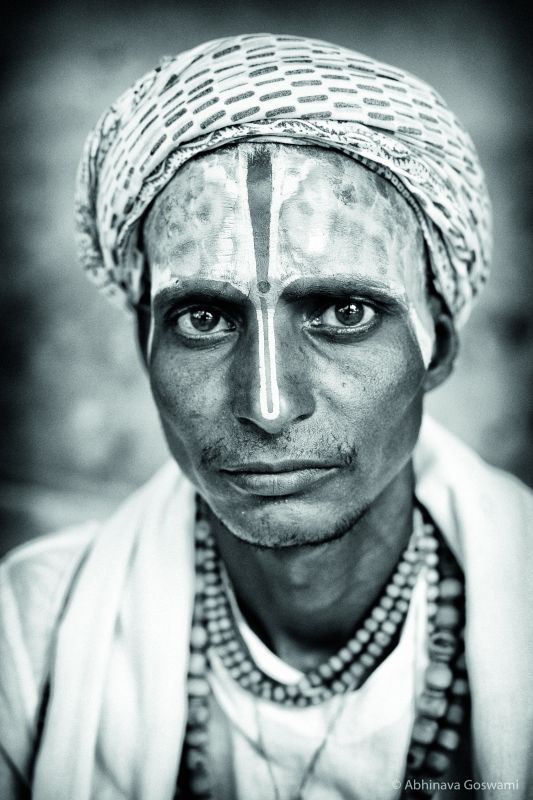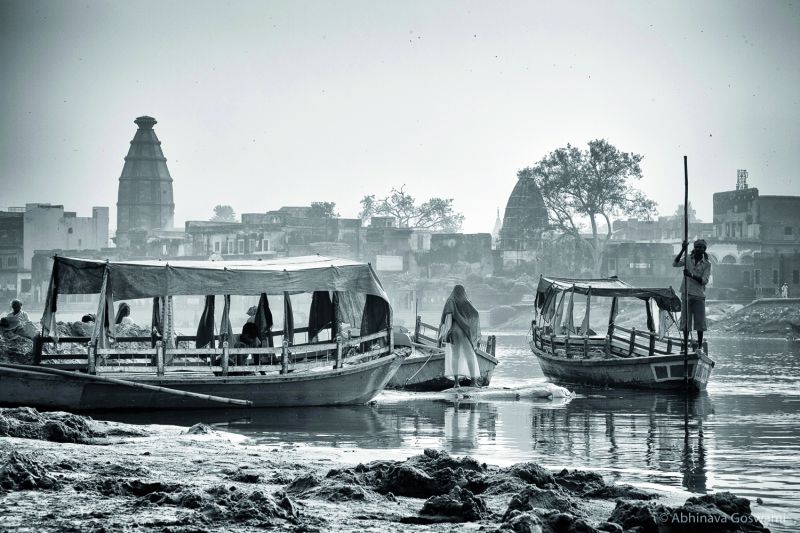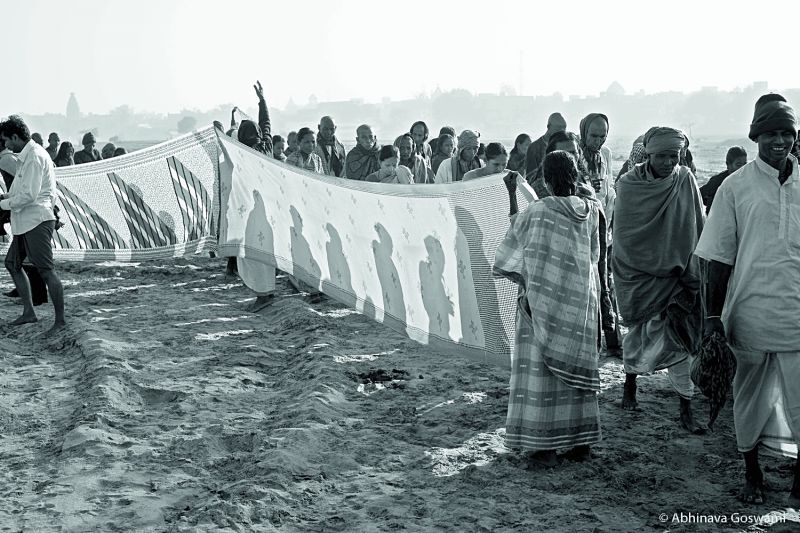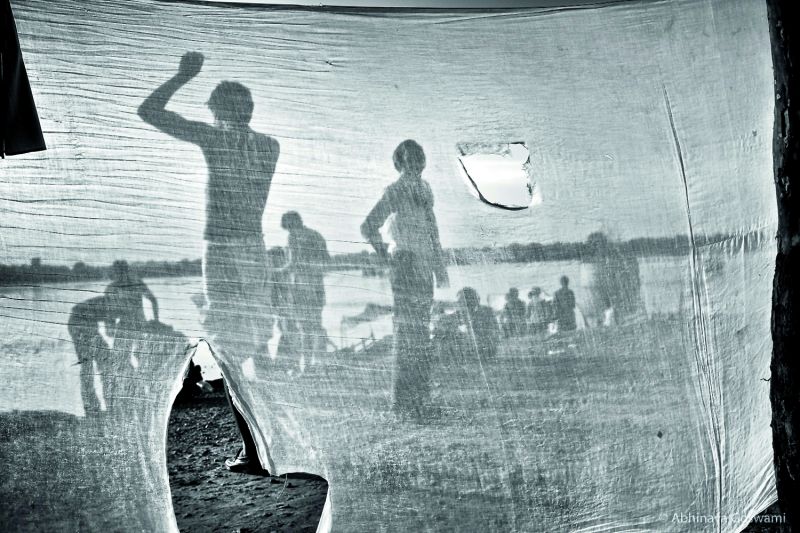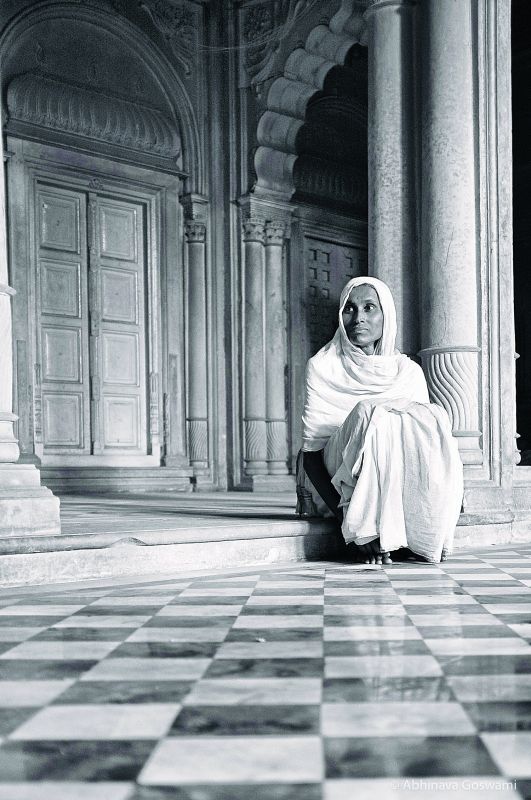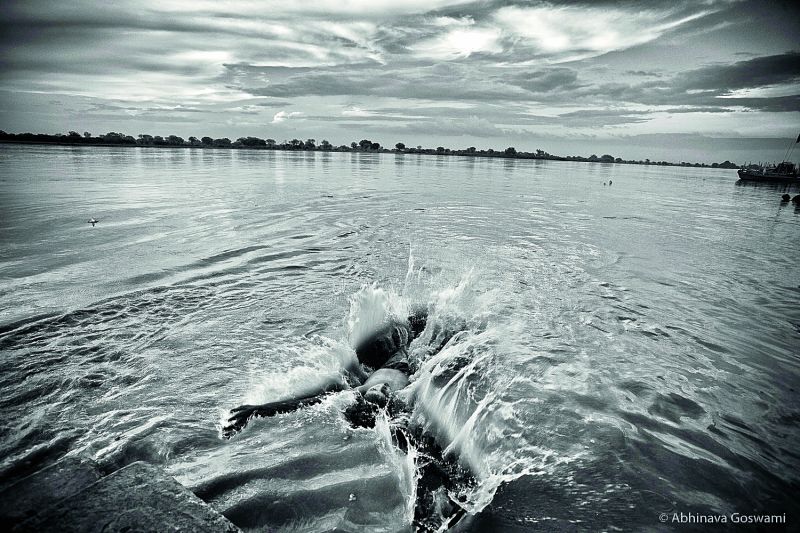10 Then Lalita Sundari leaps like a flash lightning, to the center of the circle, which is dark like a cloud, colored by Krishna’s aṅga-kānti! As the bangles on her lotus hand resound, jhana jhana jhana, she smiles and loudly recites: thai thai thotho tigaḍa tigathai tho ! tathai tho tathaitā !
11 Next Vishakha takes her turn and dances in harmony with the kana kana kana of the vina and the mridanga’s drimi drimi drimi dho dho dho! Then, while she shows her dancing expertise, her ornaments make a jhanana jha-jhat sound to her recitation of the bola: dṛgiti dṛgiti dṛk ! thai tho tatho tho
12 One gopa sundari comes forward to dance: the nupuras and kinkinis jingle on her feet and waist; she shakes her wrists making the bangles jangle and excitedly utters: thaiyā tathaiyā tatha-thai tathaiyā!
13 Another sakhi swiftly moves her hands and footsteps to make her bangles jangle and her anklebells tinkle; and with those sounds she recites the bola for the following beat: thai, thai thai thai thai tathai, thai tathai thāḥ!
14 Another gopa ramani comes on to the stage to display her talents; she boldly utters:
thaiyā thaiyā tigaḍa tathaiyā!
Rasa-taraṅginī Tīkā: Kṛṣṇa-bhāvanāmṛta adds: Seeing the Vraja sundaris’ fantastic dancing, one might consider, “Oh, after Kandarpa churned the saundaryāmṛta-sāgara (ocean of beautiful divine nectar)—are these the Lakshmis that surfaced? And have they advented on the Rasa maṇḍala to display their supreme skill to the world?” (19.67)
But seeing Krishna’s many murtis dancing between each gopi one might guess: “Oh, here’s Kandarpa’s japa mala! But what is it made of? Could it be the lightning amongst the clouds? Or is it indranila mani with gold? Or perhaps it’s fashioned with champak flowers and blue lotus? Oh, now I see, this sweet mala is molded from kunkum and deer musk!” (19.68)
hastaka-śasta-padartha-vibheda-
khyāpana-tāla-gati-krama-nāṭyāt |
ye parirambha-kucagraha-cumbās
te na tataḥ pṛthag āsata rāsāt ||
The Rasa consists of all these things: the gopis perform the drama of showing moons, lotuses and other objects with their flowing hand movements. But Krishna’s embracing them, touching their breasts and kissing them are not separable from this Rasa. (19.69)
15 While enjoying the gopa kishoris’ dancing, Krishna joyfully sings: aa ia tia, ati ai a tiaa, a a a! Hey Radhe! Just see! The moonlit Yamuna’s bank is dancing with us: a a a, ati a a! And Priye! The forest is dancing with its Malayan breezes! a a a ati ihai!” Thus singing, Krishna begins dancing also.
Rasa-taraṅginī Tīkā: Nikhila kala guru Sri Krishna sings a tenaka while showing his skills in gamaka, pada and svara. In Kṛṣṇa-bhāvanāmṛta he praises Radharani as following:
jathāya dṛganta-gaṇa koraye vilāsa
tāhāte asama śobhā kāma kalā gaṇa
labhiyā mohilo mama anurāgī mana
Hey Sundari! Your face is an abode of radiant beauty, and a playground for your roaming eyes, but therein, all of the kāma keli arts display incomparable wonder to enchant my enthralled mind!
16 Rai Vinodini dances and sings: “Oh hey Priya! Your smile is effulgent like the moon, softer than the kunda flowers, more playful than the swan, tastier than khira, and glossier than a pearl necklace—ai, aai, aare are ai aai a!
Rasa-taraṅginī Tīkā: To answer Krishna, Sudhamukhi Rai sings this poem while displaying her manohara nritya. Then combining sura, tāla, māna and laya she concludes with a tenaka.
17 Though they appear like dull objects, the mohana mridangas are actually great pandits—for they resound tā dhik, tā dhik, tā dhik! to spite the heavenly devis’ dancing, which cannot be compared to that of the vidagdha Vraja sundaris.
Rasa-taraṅginī Tīkā: Tā dhik is a mridanga bola, but it also means “shame on them.” Being the greatest saṅgīta acharyas, Radha Thakurani and the other Vraja sundaris display a unique standard of rāgas and rāgiṇīs, tālas, manas, mūrchanās, śrutis and gamakas. Hence the Rasa raṅga sthali is the most amazing stage for music within the three worlds! So as Urvasi, Menaka, Rambha, Tilottama and other leading saṅgīta acharyas of heaven watch the Rasa spectacle from the clouds, the gopis’ mridangas point at them and resound tā dhik, tā dhik, tā dhik! (“Shame on them! Shame on them! Shame on them!”) to proclaim the Vraja sundaris’ superiority.
18-20 Then the gopis singing and playing the vinas, the flutes, the mridangas and the other instruments ecstatically get up to join with the dancing. As the Vraja sundaris lose themselves in the Rasa’s splendor, their nivi-bandhanas, kanchulis and braided hairs unfasten. Thus Rasika-mohana swiftly dances near to retie them. Using the scale sā ri ga ma pa da ni, the very expert gopa kishoris create newer and newer rāgas and rāgiṇīs.
Rasa-taraṅginī Tīkā: There are more than sixteen thousand varieties.
21 With thousands of voices and with thousands of songs, the Vraja Devis sing śuddha (unchanged) and saṅkīrṇa (mixed) songs beloning to the mārga (heavenly) and deśīya (wordly) category.
Rasa-taraṅginī Tīkā: The mārga singing of heaven is also called svarga saṅgīta and Lord Brahma is its acharya. Music used to entertain worldly kings is called deśīya.
The post Govinda Lilamrita : The beat quickens appeared first on Vrindavan Today.



 No consensus in meeting on Biharji development work. Tuesday, Vrindavan: Banke Bihari Goswamis met with officials from
No consensus in meeting on Biharji development work. Tuesday, Vrindavan: Banke Bihari Goswamis met with officials from 










 Seeing his friends and cows in this condition and considering this poisoned water to be a threat to the entire community, Krishna jumped from a tall kadamba tree standing on the bank of the lake and directly into the coils of the angry Kaliya snake, where he remained motionless for some time. But when he saw that his friends, cows, mother, father, the gopas and gopis, indeed all the Vrajavasis, were almost losing consciousness due to fears for his safety, Krishna came out of the grip of Kaliya’s coils, climbed on his hoods and began to kick him by dancing on them. This is described in Śrīmad Bhāgavatam (10.16.25-30) as follows:
Seeing his friends and cows in this condition and considering this poisoned water to be a threat to the entire community, Krishna jumped from a tall kadamba tree standing on the bank of the lake and directly into the coils of the angry Kaliya snake, where he remained motionless for some time. But when he saw that his friends, cows, mother, father, the gopas and gopis, indeed all the Vrajavasis, were almost losing consciousness due to fears for his safety, Krishna came out of the grip of Kaliya’s coils, climbed on his hoods and began to kick him by dancing on them. This is described in Śrīmad Bhāgavatam (10.16.25-30) as follows:








